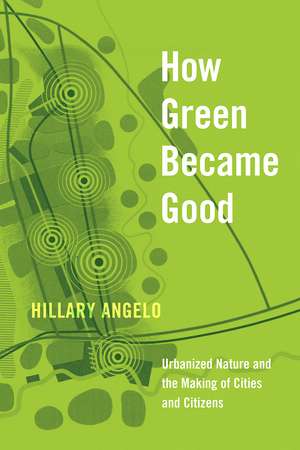How Green Became Good: Urbanized Nature and the Making of Cities and Citizens
Autor Hillary Angeloen Limba Engleză Paperback – 4 feb 2021
| Toate formatele și edițiile | Preț | Express |
|---|---|---|
| Paperback (1) | 199.96 lei 3-5 săpt. | +14.65 lei 4-10 zile |
| University of Chicago Press – 4 feb 2021 | 199.96 lei 3-5 săpt. | +14.65 lei 4-10 zile |
| Hardback (1) | 674.61 lei 6-8 săpt. | |
| University of Chicago Press – 4 mar 2021 | 674.61 lei 6-8 săpt. |
Preț: 199.96 lei
Nou
Puncte Express: 300
Preț estimativ în valută:
38.27€ • 39.71$ • 31.98£
38.27€ • 39.71$ • 31.98£
Carte disponibilă
Livrare economică 24 februarie-10 martie
Livrare express 07-13 februarie pentru 24.64 lei
Preluare comenzi: 021 569.72.76
Specificații
ISBN-13: 9780226739045
ISBN-10: 022673904X
Pagini: 264
Ilustrații: 14 halftones
Dimensiuni: 152 x 229 x 18 mm
Greutate: 0.38 kg
Ediția:First Edition
Editura: University of Chicago Press
Colecția University of Chicago Press
ISBN-10: 022673904X
Pagini: 264
Ilustrații: 14 halftones
Dimensiuni: 152 x 229 x 18 mm
Greutate: 0.38 kg
Ediția:First Edition
Editura: University of Chicago Press
Colecția University of Chicago Press
Notă biografică
Hillary Angelo is assistant professor of sociology at the University of California, Santa Cruz. Her work has been published in Theory and Society, the International Journal of Urban and Regional Research, and Nature, among other journals.
Cuprins
Introduction: Urban Greening beyond Cities
Part 1 Green Becomes Good
1 The Imaginative Turn to the City
2 Building an Urban Future through Nature
Part 2 Contested Social Ideals
3 The Space-Time of Democracy: Parks as a Bourgeois Public Sphere
4 Proletarian Counterpublics: Reimagining the Colonies
Part 3 The Social Life of Urbanized Nature
5 Producing Nature, Projecting Urban Futures
6 Experiencing Nature as a Public Good
Conclusion: Global Greening Today
Acknowledgments
References
Index
Part 1 Green Becomes Good
1 The Imaginative Turn to the City
2 Building an Urban Future through Nature
Part 2 Contested Social Ideals
3 The Space-Time of Democracy: Parks as a Bourgeois Public Sphere
4 Proletarian Counterpublics: Reimagining the Colonies
Part 3 The Social Life of Urbanized Nature
5 Producing Nature, Projecting Urban Futures
6 Experiencing Nature as a Public Good
Conclusion: Global Greening Today
Acknowledgments
References
Index
Recenzii
“Angelo risks sacrilege; she takes on nature as a mundane tool of politics, entertainment, and real estate. The ideology of green comes out of its black box, exposed to insightful and historically aware analysis.”
“Written with verve and meticulous attention to historical detail, How Green Became Good illuminates the hows and whys of the contemporary phenomenon of ‘urbanized nature.’ Angelo convincingly moves from micro-level investigations of moral judgments and responses surrounding pet rabbits to macro-level examinations of top-down globalized urban greening projects. A tour de force, this book will prompt a rethinking of the green-as-good reflex."
"How Green Became Good takes the conventional western urban imagination out of Chicago’s Loop and past Los Angeles’s Sixty-Mile-Circle to the expanse of the Ruhr and rewrites urban theory from there. This brilliant book on more than a century of “urbanized nature” in Germany’s former industrial heartland will forever change our views of the industrial city as preceding the green city. If you are looking for a concept of the urban beyond the Zwischenstadt, you will find it in Angelo’s magisterial contribution."
"How Green Became Good is an exceptionally robust work of historical sociology, shown by the fact that Angelo not only provides the reader with the historical specifics of each greening project analyzed in the book, but also uses those details to skillfully build a general theoretical explanation for how urban greening works as a social process. . . . Angelo’s work serves as a model for other scholars inclined to take a historical approach to answering question sin urban sociology and urban studies."
"How Green Became Good is a powerful work of urban sociology, culture, and historical and comparative methods. In it, Hillary Angelo challenges conventional accounts of why urban greening became a public good."
"Interested in how planning projects, specifically those sold as 'green,' can exacerbate or ignore existing inequalities. . . Angelo’s more specific question is why have all types of cities taken up 'greening' projects
rather than just large, industrial cities? . . . Taken on their own terms, these projects have been remarkable successes, ecologically and economically, but Angelo’s point is clear: the 'greening' at the core of their
conceptions has blunted social criticism. . ."
rather than just large, industrial cities? . . . Taken on their own terms, these projects have been remarkable successes, ecologically and economically, but Angelo’s point is clear: the 'greening' at the core of their
conceptions has blunted social criticism. . ."
"These interventions deserve wide reading by all sociologists, not just urban sociologists or environmental sociologists."
